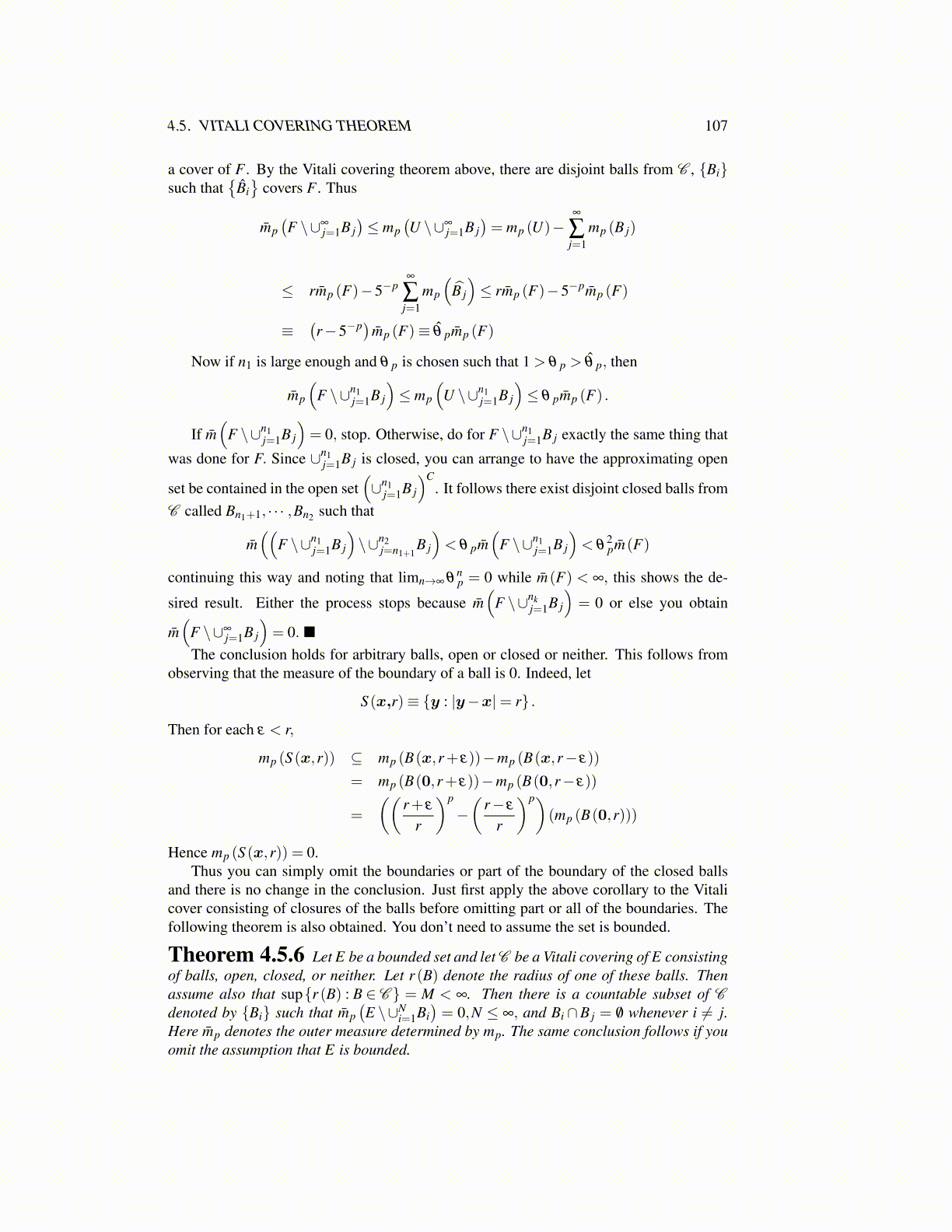
4.5. VITALI COVERING THEOREM 107
a cover of F . By the Vitali covering theorem above, there are disjoint balls from C , {Bi}such that
{B̂i}
covers F . Thus
m̄p(F \∪∞
j=1B j)≤ mp
(U \∪∞
j=1B j)= mp (U)−
∞
∑j=1
mp (B j)
≤ rm̄p (F)−5−p∞
∑j=1
mp
(B̂ j
)≤ rm̄p (F)−5−pm̄p (F)
≡(r−5−p) m̄p (F)≡ θ̂ pm̄p (F)
Now if n1 is large enough and θ p is chosen such that 1 > θ p > θ̂ p, then
m̄p
(F \∪n1
j=1B j
)≤ mp
(U \∪n1
j=1B j
)≤ θ pm̄p (F) .
If m̄(
F \∪n1j=1B j
)= 0, stop. Otherwise, do for F \∪n1
j=1B j exactly the same thing that
was done for F. Since ∪n1j=1B j is closed, you can arrange to have the approximating open
set be contained in the open set(∪n1
j=1B j
)C. It follows there exist disjoint closed balls from
C called Bn1+1, · · · ,Bn2 such that
m̄((
F \∪n1j=1B j
)\∪n2
j=n1+1B j
)< θ pm̄
(F \∪n1
j=1B j
)< θ
2pm̄(F)
continuing this way and noting that limn→∞ θnp = 0 while m̄(F) < ∞, this shows the de-
sired result. Either the process stops because m̄(
F \∪nkj=1B j
)= 0 or else you obtain
m̄(
F \∪∞j=1B j
)= 0. ■
The conclusion holds for arbitrary balls, open or closed or neither. This follows fromobserving that the measure of the boundary of a ball is 0. Indeed, let
S (x,r)≡ {y : |y−x|= r} .
Then for each ε < r,
mp (S (x,r)) ⊆ mp (B(x,r+ ε))−mp (B(x,r− ε))
= mp (B(0,r+ ε))−mp (B(0,r− ε))
=
((r+ ε
r
)p
−(
r− ε
r
)p)(mp (B(0,r)))
Hence mp (S (x,r)) = 0.Thus you can simply omit the boundaries or part of the boundary of the closed balls
and there is no change in the conclusion. Just first apply the above corollary to the Vitalicover consisting of closures of the balls before omitting part or all of the boundaries. Thefollowing theorem is also obtained. You don’t need to assume the set is bounded.
Theorem 4.5.6 Let E be a bounded set and let C be a Vitali covering of E consistingof balls, open, closed, or neither. Let r (B) denote the radius of one of these balls. Thenassume also that sup{r (B) : B ∈ C } = M < ∞. Then there is a countable subset of Cdenoted by {Bi} such that m̄p
(E \∪N
i=1Bi)= 0,N ≤ ∞, and Bi ∩B j = /0 whenever i ̸= j.
Here m̄p denotes the outer measure determined by mp. The same conclusion follows if youomit the assumption that E is bounded.